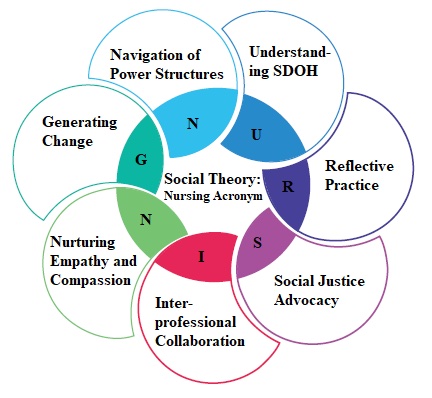In nursing, Critical Theory is used to analyze and challenge the structure of power, politics, and injustice, particularly within health systems. It encourages nurses to investigate and change existing systems, which may contribute to health disparities, and to advocate for social justice.
I applied each letter of the word “NURSING” to Critical Theory to align fundamental nursing concepts with the principles of critical theory, focused on challenging power structures, promoting equity, and advocating for social justice in healthcare.


N: Navigation of power structures
Nurses can use Critical Theory to navigate and challenge the power dynamics within healthcare systems. This includes recognizing how policies, practices, and institutional/hospitals structures can contribute to health disparities and then working toward changes that promote fairness and equality.
U: Understanding social determinants of health
Critical Theory encourages nurses to understand how social determinants of health (for example, socioeconomic status, race, and environment) affect patient health outcomes. By this understanding this connection, nurses can help provide holistic care that addresses the social and environmental aspects of the patient’s health.
R: Reflective practice
Reflective practice focuses on the ability of the nurses to critically assess ones’ beliefs and biases to help them become more aware of how their actions can perpetuate or challenge systemic inequalities. Nurses also are encouraged to reflect on their practice to identify ways to advocate for more equitable care.
S: Social justice advocacy
The core of Critical Theory in nursing is advocacy for social justice. The nursing profession gives nurses the voice to demand and fight for adequate policies and practices to help vulnerable groups and those with limited healthcare access.
I: Interprofessional collaboration
Critical Theory promotes interprofessional collaboration to address complex health issues. Nurses themselves and in collaboration with other healthcare practitioners, the community, and patients can develop and execute plans that will help overcome injustice and health disparities.
N: Nurturing empathy and compassion
Nurses nurture empathy and compassion for all patients, particularly those from marginalized groups. This can be done by critically assessing and identifying the structural prejudices that such patients may encounter and working for their entitlements in healthcare facilities.
G: Generating change
Nurses play a key role in generating change within the healthcare system. Critical Theory encourages a nurse to fight for policy changes and work to improve the quality of care delivery.
Fadi Zaben is a Doctoral Candidate, Faculty of Nursing, University of Jordan, Amman, Jordan and lecturer on the Faculty of Medicine and Health Sciences, An-Najah National University, Nablus, Palestine, Department of Nursing and Midwifery,
References
Celikates, R., & Flynn, J. (2023). Critical theory (Frankfurt School).
Dawson J, Laccos-Barrett K, Hammond C, Rumbold A. Reflexive practice as an approach to improve healthcare delivery for indigenous peoples: A systematic critical synthesis and exploration of the cultural safety education literature. Int J Environ Res Public Health. 2022;19(11):6691. doi:10.3390/ijerph19116691
DePoy E, Gitlin LN. Naturalistic designs. Introduction to Research. Philadelphia, PA: Elsevier; 2021.
Dickson E, Lobo ML. Critical caring theory and public health nursing advocacy for comprehensive sexual health education. Public Health Nurs. 2018;35(1):78-84. doi:10.1111/phn.12369
Flaubert JL, Le Menestrel S, Williams DR, Wakefield MK. Nurses leading change. In: The Future of Nursing 2020-2030: Charting a Path to Achieve Health Equity. National Academies Press; 2021.
Guilamo-Ramos V, Johnson C, Thimm-Kaiser M, Benzekri A. Nurse-led approaches to address social determinants of health and advance health equity: A new framework and its implications. Nurs Outlook. 2023;71(6):101996. doi:10.1016/j.outlook.2023.101996
McLain BR. Collaborative practice: A critical theory perspective. Res Nurs Health. 1988;11(6):391-8. doi: 10.1002/nur.4770110607
Mosqueda-Díaz A, Vílchez-Barboza V, Valenzuela-Suazo S, Sanhueza-Alvarado O. Critical theory and its contribution to the nursing discipline. Invest Educ Enferm. 2014;32(2):356-3. doi:10.17533/udea.iee.v32n2a18
Todic J, Cook SC, Spitzer-Shohat S, et al. Critical theory, culture change, and achieving health equity in health care settings. Acad Med. 2022;97(7):977-88. doi:10.1097/ACM.0000000000004680

















